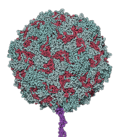Poliovirus
Poliovirus is a member of the family Picornaviridae and the genus Enterovirus. It is an RNA virus that causes poliomyelitis, a disease that can lead to paralysis.
Structure[edit]
Poliovirus is a non-enveloped virus with an icosahedral symmetry. Its capsid is composed of 60 copies each of four different viral proteins. The genome of the poliovirus is a single-stranded positive-sense RNA molecule approximately 7500 nucleotides long.
Life Cycle[edit]
The life cycle of the poliovirus begins when it attaches to a receptor on the surface of a host cell. The virus then enters the cell and uncoats its RNA genome. The RNA is translated into a polyprotein, which is then cleaved into individual viral proteins. These proteins and the viral RNA assemble into new virus particles, which are released from the cell to infect other cells.
Pathogenesis[edit]
Poliovirus primarily infects the gastrointestinal tract, but it can also spread to the central nervous system and cause paralysis. The virus is transmitted through the fecal-oral route, and it can survive in the environment for several weeks.
Prevention and Treatment[edit]
There is no cure for poliomyelitis, but it can be prevented with the polio vaccine. There are two types of polio vaccines: the inactivated polio vaccine (IPV) and the oral polio vaccine (OPV). Both vaccines stimulate the immune system to produce antibodies against the poliovirus.
See Also[edit]
References[edit]
<references />
Ad. Transform your life with W8MD's Budget GLP-1 injections from $75


W8MD offers a medical weight loss program to lose weight in Philadelphia. Our physician-supervised medical weight loss provides:
- Weight loss injections in NYC (generic and brand names):
- Zepbound / Mounjaro, Wegovy / Ozempic, Saxenda
- Most insurances accepted or discounted self-pay rates. We will obtain insurance prior authorizations if needed.
- Generic GLP1 weight loss injections from $75 for the starting dose.
- Also offer prescription weight loss medications including Phentermine, Qsymia, Diethylpropion, Contrave etc.
NYC weight loss doctor appointmentsNYC weight loss doctor appointments
Start your NYC weight loss journey today at our NYC medical weight loss and Philadelphia medical weight loss clinics.
- Call 718-946-5500 to lose weight in NYC or for medical weight loss in Philadelphia 215-676-2334.
- Tags:NYC medical weight loss, Philadelphia lose weight Zepbound NYC, Budget GLP1 weight loss injections, Wegovy Philadelphia, Wegovy NYC, Philadelphia medical weight loss, Brookly weight loss and Wegovy NYC
|
WikiMD's Wellness Encyclopedia |
| Let Food Be Thy Medicine Medicine Thy Food - Hippocrates |
Medical Disclaimer: WikiMD is not a substitute for professional medical advice. The information on WikiMD is provided as an information resource only, may be incorrect, outdated or misleading, and is not to be used or relied on for any diagnostic or treatment purposes. Please consult your health care provider before making any healthcare decisions or for guidance about a specific medical condition. WikiMD expressly disclaims responsibility, and shall have no liability, for any damages, loss, injury, or liability whatsoever suffered as a result of your reliance on the information contained in this site. By visiting this site you agree to the foregoing terms and conditions, which may from time to time be changed or supplemented by WikiMD. If you do not agree to the foregoing terms and conditions, you should not enter or use this site. See full disclaimer.
Credits:Most images are courtesy of Wikimedia commons, and templates, categories Wikipedia, licensed under CC BY SA or similar.
Translate this page: - East Asian
中文,
日本,
한국어,
South Asian
हिन्दी,
தமிழ்,
తెలుగు,
Urdu,
ಕನ್ನಡ,
Southeast Asian
Indonesian,
Vietnamese,
Thai,
မြန်မာဘာသာ,
বাংলা
European
español,
Deutsch,
français,
Greek,
português do Brasil,
polski,
română,
русский,
Nederlands,
norsk,
svenska,
suomi,
Italian
Middle Eastern & African
عربى,
Turkish,
Persian,
Hebrew,
Afrikaans,
isiZulu,
Kiswahili,
Other
Bulgarian,
Hungarian,
Czech,
Swedish,
മലയാളം,
मराठी,
ਪੰਜਾਬੀ,
ગુજરાતી,
Portuguese,
Ukrainian









